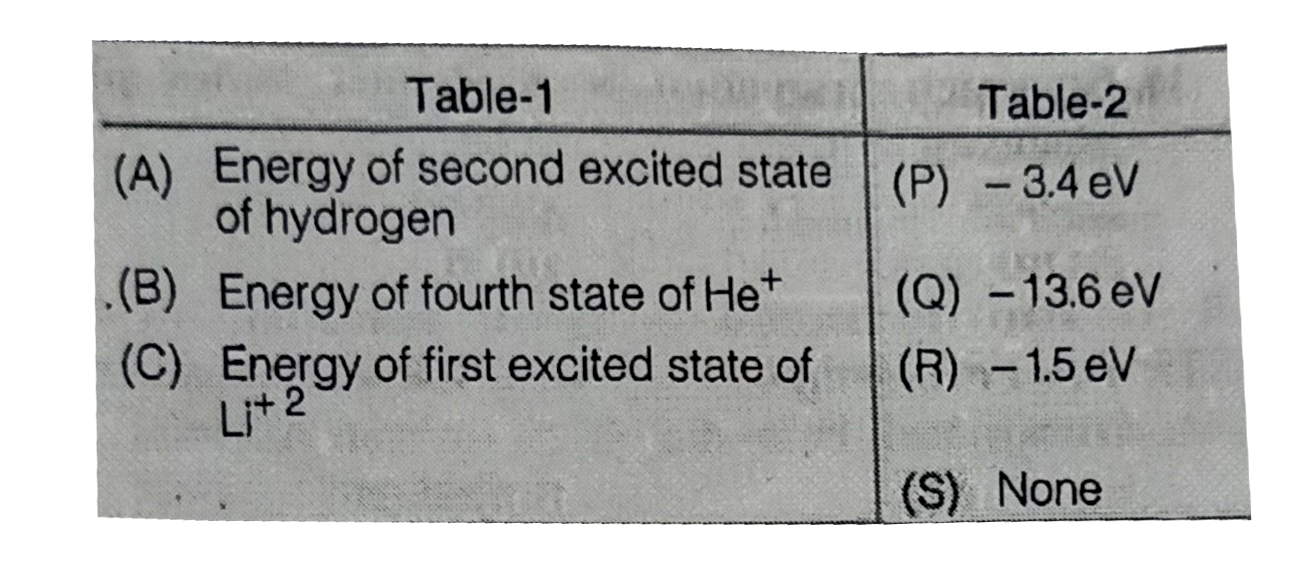Ionization potential of hydrogen atom is 13.6V. Hydrogen atoms in the ground state are excited by monochromatic radiation of photon energy 12.1eV. The spectral lines emitted by hydrogen atoms according to Bohr's theory will be
two
three
four
one
The correct Answer is:B
To solve the problem regarding the spectral lines emitted by hydrogen atoms after being excited by monochromatic radiation, we can follow these steps:
Step 1: Understand the Ionization Potential
The ionization potential of a hydrogen atom is given as 13.6 eV. This means that to completely remove the electron from the ground state (n=1), we need to provide at least 13.6 eV of energy.
Step 2: Determine the Energy Levels
According to Bohr's model, the energy of an electron in the nth orbit of a hydrogen atom is given by the formula:
En=−13.6eVn2
For the ground state (n=1):
E1=−13.6eV
For the first excited state (n=2):
E2=−13.622=−3.4eV
For the second excited state (n=3):
E3=−13.632≈−1.51eV
Step 3: Calculate the Final Energy State After Excitation
The hydrogen atom is excited by a photon with energy 12.1 eV. The initial energy of the atom in the ground state is -13.6 eV. After absorbing the photon, the total energy becomes:
Efinal=E1+Photon Energy=−13.6eV+12.1eV=−1.5eV
This energy corresponds to the energy level of n=3, since:
E3≈−1.51eV
Step 4: Identify Possible Transitions
The electron is now in the n=3 state. It can transition to lower energy levels (n=2 or n=1) and emit photons. The possible transitions are:
1. From n=3 to n=2
2. From n=3 to n=1
Step 5: Calculate the Number of Spectral Lines
The number of spectral lines emitted when an electron transitions from level n to lower levels can be calculated using the formula:
Number of lines=n(n−1)2
For n=3:
Number of lines=3(3−1)2=3⋅22=3
Conclusion
Thus, the number of spectral lines emitted by hydrogen atoms according to Bohr's theory after being excited by the photon energy of 12.1 eV is 3.
---
The ionization potential of a hydrogen atom is given as 13.6 eV. This means that to completely remove the electron from the ground state (n=1), we need to provide at least 13.6 eV of energy.
According to Bohr's model, the energy of an electron in the nth orbit of a hydrogen atom is given by the formula:
En=−13.6eVn2
For the ground state (n=1):
E1=−13.6eV
For the first excited state (n=2):
E2=−13.622=−3.4eV
For the second excited state (n=3):
E3=−13.632≈−1.51eV
The hydrogen atom is excited by a photon with energy 12.1 eV. The initial energy of the atom in the ground state is -13.6 eV. After absorbing the photon, the total energy becomes:
Efinal=E1+Photon Energy=−13.6eV+12.1eV=−1.5eV
This energy corresponds to the energy level of n=3, since:
E3≈−1.51eV
The electron is now in the n=3 state. It can transition to lower energy levels (n=2 or n=1) and emit photons. The possible transitions are:
1. From n=3 to n=2
2. From n=3 to n=1
The number of spectral lines emitted when an electron transitions from level n to lower levels can be calculated using the formula:
Number of lines=n(n−1)2
For n=3:
Number of lines=3(3−1)2=3⋅22=3
Thus, the number of spectral lines emitted by hydrogen atoms according to Bohr's theory after being excited by the photon energy of 12.1 eV is 3.
Similar Questions
Ionization potential of hydrogen atom is 13.6 eV. Hydrogen atoms in the ground state are excited by monochromatic radiation of photon energy 12.1 eV. According to Bohr's theory, the spectral lines emitted by hydrogen will be
View SolutionIonisation potential of hydrogen atom is 13.6eV. Hydrogen atom in ground state is excited by monochromatic light of energy 12.1eV. The spectral lines emitted by hydrogen according to Bohr's theory will be
View SolutionAn H- atom in the ground state is excited by monochromatic radiation of photon energy 13.056 eV. The number of emission lines will be (given its ionisation energy is 13.6 eV)
View SolutionHydrogen atom in ground state is excited by a monochromatic radiation of λ=975Å. Number of spectral lines in the resulting spectrum emitted will be
View SolutionA sample consisting of Hydrogen atoms in the ground state is excited by monochromatic radiation of energy 12.75 eV. If we were to observe the emission spectrum of this sample, then the number of spectral lines observed, will be
View SolutionExcitations energy of hydrogen atom is 13.6eV match the following

View SolutionThe ionisation potential of hydrogen atom is -13.6 eV. An electron in the ground state of a hydrogen atom absorbs a photon of energy 12.75 eV. How many diggerent spectral lines can one expect when the electron make a downward transition
View SolutionThe energy of electron in an excited hydrogen atom is −3.4eV. Its angular momentum according to bohr's theory will be
View SolutionThe hydrogen atom in ground state is excited by a monochromatic radiation of wavelength λ=1025A. The possible number of emmision spectral lines in the spectrum will be (hc = 12400 eV A)
View SolutionA hydrogen atom in the ground state is excited by an electron beam of 12.5 eV energy. Find out the maximum number of lines emitted by the atom from its excited state.
View Solution
